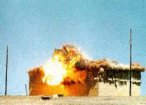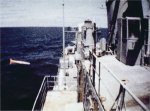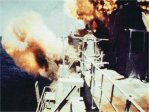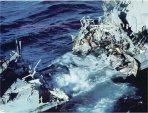 |
 |
 |
 |

![[image of flower]](../ima/flowXS_04.gif)
![[image of flower]](../ima/flowXS_04.gif)
How Guided Missiles Work |
|
Note: Click on photos to enlarge them. Current warfare techniques include many technical advances. In the news, one often hears of "smart" bombs, satellite communications, GPS (Global Positioning System), radar, and guided missiles. This is a description of guided missiles. A guided missile is an unmanned explosive-carrying vehicle that moves above the earth's surface in a flight path controlled by an external or internal source. There are many kinds of guided missiles, but all have the same ultimate function: destroy enemy "targets", i.e., personnel, tanks, vehicles, airplanes, ships, and weapons, including attacking missiles. 

Other missiles are used offensively or defensively over shorter distances - from a few to a few hundred miles. These are "tactical" missiles. Missiles can be launched from ships, planes and the ground at targets
located on ships, planes and the ground; hence, the classifications as ground to ground
Tow, ship to ground
Cruise,
ground-to-air Stinger,
air-to-ground Amraam,
Apache, ship-to-air
Standard Missile, and so forth. Missiles can have
weird configurations:  I will describe, first, missile parts and their functions, second, missile deployment, and finally, how a missile is launched to intercept and destroy its target. 


Missile Parts and Their Functions.A tactical missile is from 5 to 20 feet long, 6 inches to 1 foot in diameter, and weighs from 200 to 2,000 pounds. The size is determined by the expected distance to the target (longer distances require more fuel capacity) and the type of target (bigger, heavier targets required more explosive). ' Most of the missile body is made of a titanium alloy, which provides high strength and low weight. Inside the missile are hundreds of electronic, digital and mechanical subsystems that perform thousands of operations to guide the missile from its launcher to its target. A tactical missile travels at about the speed of sound (700 mph), but some travel almost twice that speed. Each missile costs tens to hundreds of thousands of dollars. Its flight time is measured in seconds. A missile can be divided functionally into 8 sections: radome, guidance, warhead, autopilot, dorsal fins, rocket motor, steering control and control surfaces. These missile sections are described below. 1. Radome.
A housing made of ceramic material similar to the household
"Corningware" and located at the front end ("nose") of the missile. Here
are some radomes on the production line 2. Guidance. A system that receives radio information from its launch controller (a computer, not a human), directing it to launch the missile and calculate its most efficient path to the target. The Guidance system also transmits all missile functions back to its launch controller for continuous monitoring of missile subsystem performance. 3. Warhead. A system containing missile internal "homing" radar and an explosive surrounded by thousands of serrated iron pieces or other destroying material, depending on the nature of the anticipated target. As the missile approaches ("homes in on") the target, its internal radar electronically "sees" and locks onto the target to guide the missile towards it. Not all missiles have this "homing" radar. If not, its launch control must continuously direct it to the target. 4. Autopilot. A system that provides missile location, direction, velocity and "attitude" (up, down sideways, etc.) and the capacity to change its motion via the Control Surfaces (see below). The Autopilot contains an antenna to receive and transmit information to its home controller. It also contains a battery that supplies electrical power to the missile electronic and microprocessor components. &bnsp; Transmissions to and from the missile must be encoded and decoded to prevent electronic spying by other countries' surveillance radars. 5. Dorsal Fins. The fins, along with the missile body, provide surfaces against which air exerts pressure. These dorsal surfaces are used by the Control Surfaces (see below) to change the direction and attitude of the missile. 6. Rocket Motor. A mixture of solid chemical fuels. When ignited, the chemicals propel the missile from its launcher into space. 7. Steering Control. A system that electrically changes the Control Surfaces (see below) that change the missile motion. It reacts to information sent to it by the Autopilot (see above). 8. Control Surfaces. These are four "fins" that act against air resistance to change the direction of the missile. In summary, a guided missile is a combination of electrical, digital and mechanical parts segregated into sections. Each section has specific functions that must operate accurately and safely; otherwise, the missile mission is electronically aborted and the missile is destroyed. Internal controls monitor each function to assure proper coordination among parts. This information is radioed to the launch controller, so that it knows at all times how well each part of the missile is performing to achieve the missile's ultimate goal of destroying the target. Missile Deployment.After a missile is manufactured, it must be transported to its launch platform. This can be an airplane, helicopter, truck, jeep, soldier, or ship from which it is carried, launched and controlled. In a ship, for example, an encanistered ship missile is moved by trucks and cranes. Here is a Patriot canister. Some missiles are not encanistered; they are just placed unenclosed on their launching platform as these examples show: shoulder, plane, helicopter, plane, plane, jeep.
Missile Launch & Target-destruction Process.The missile launching and target destruction process can be divided into seven stages: long-range and short-range surveillance, target identification, target tracking, missile pre-launch, launch, midcourse guidance, homing, and intercept. Each of these phases is described below: 1. Surveillance.
A systematic search by the launcher (ship, plane, or
ground station) radars and more
radars for targets in the
hemisphere surrounding it. Another
target tracking diagram that starts from search at the
lower right and ends with intercept at the upper left. 2. Identification: "Friend or foe?". All commercial and military airplanes and some weapons and personnel have "transponders", which are receiver- transmitters that receive radio signals on one frequency and return a specific identification (ID) signal on another frequency. When the target code matches a "friendly" code in the launcher electronic library, no launcher action is taken. However, if the ID matches a "foe" code, or if there is no response, the missile launcher assumes a "foe" and prepares to destroy the target. Tragedies can occur when a friendly transponder is inoperable. 3. Pre-launch. The Weapons Officer in charge of missile launch (in airplanes, this would be the pilot) selects a particular missile to attack the target with a push of a button. The selected missile then automatically tests ("checks") hundreds of its subsystems within milliseconds to assure their satisfactory operation. Also, the communications link from the launcher to the missile and the missile to the launcher are automatically tested for satisfactory functioning. If a subsystem or communications link fails after a few attempts, the missile declares itself inoperable (a "dud") and the Weapons Officer selects another missile. On a ship, the missiles are stored in launch boxes below deck. This image shows the white launch canister covers behind the gun on the front deck and behind the superstructure on the rear deck of the ship. 4. Launch. After a satisfactory self-test, the missile ignites its rocket motor, which provides the force to propel the missile away from its platform.

 Also, the missile battery is activated soon after launch to provide electrical power to the
missile components.
Total elapsed time from the push of the button by the Weapons
Officer to rocket ignition is only a few seconds, depending on the size
and complexity of the missile. The missile rocket motor
pushes the missile upwards and outwards from the missile container.
Also, the missile battery is activated soon after launch to provide electrical power to the
missile components.
Total elapsed time from the push of the button by the Weapons
Officer to rocket ignition is only a few seconds, depending on the size
and complexity of the missile. The missile rocket motor
pushes the missile upwards and outwards from the missile container.
Note: Once the missile is placed on its launch vehicle and electrically connected to its control center, it is ready to be fired by the Weapons Officer. (In an airplane, the Weapons Officer is the pilot.) This is true for encanistered and non-canistered missiles. There is no missile storage from which the missiles have to be physically moved to the ready position. They are always ready to launch from their initial position and need merely be activated by the Weapons Officer. 5. Tracking. The launcher "tracking" radar continuously monitors the target, while computers continuously calculate target location, direction and speed. Human judgment is involved in identification too. 


6. Midcourse. During missile flight, target location, direction, and speed are continuously calculated by the launcher radar. This information is transmitted from the ship (or plane, or truck) to the missile via radar, which adjusts its course to intercept the target. Missile functioning is continuously transmitted to the launcher via radio. 7. Homing. When the missile
approaches target vicinity, it activates its own radar and searches for the target itself, so
that launcher radar no longer is required. The image below is what a target missile
(one attacking you) looks
like to the attacking missile (one you use to counterattack the attacker): 
Note: Not all missiles have their own tracking radar. If not, then the controller at the launching ship, plane or truck must provide continuous tracking of the missile to its target. 8. Intercept (target destruction).
The missile IR (Infra-Red) "seeker" determines when the target is at
the optimum distance for maximum explosive effect, whereupon it sends a
signal to the warhead to detonate. The explosive scatters serrated iron
fragments or other destroying material in all directions. Some of these
fragments are expected to impair target functioning. When that occurs, the
target is a "kill". 

 . . However, missiles don't always destroy the target. "Misses" and "near misses" occur too! The above process describes how a guided missile is launched, guided and exploded to destroy a target. The entire sequence is as follows: long-range and short-range surveillance, target identification, target tracking, missile pre-launch, launch, midcourse guidance, homing, and intercept (target destruction). |
 |
 |